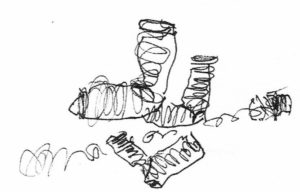Columnists
Darn it!

It’s this time of the year that my primal genes kick in and prompt responses to the drop in the thermometer hanging outside my kitchen window. The brown bear sensible thing of pulling the den together and sleeping away the winter does humour my senses I admit, but knowing there is lesser access to the fineries of life by taking that route—I mean when was the last time you saw a bear at a movie house or fine dining in February you might ask—instead I hit the sock drawer. Hell, I even wear woollen socks in my hiking boots in summer, but come the winter months the drawer turns colour like autumn leaves as the cotton socks go to the end-field bleachers and wool socks march front and centre.
If you were to inspect my sock collection, I would guide you through it as if you were in the vintage wine section at the liquor store or touring the cheese festival at the Crystal Palace. The fact that I know the terroir and provenance of most of my wool socks may seem weird to some, but ‘chacun à son goût’ as we say in our other official language. You see this fetish about wool socks and keeping my feet warm in winter is connected to family lore where I believe it was my paternal grandmother, Clara Lambert, from the upper reaches of the Saint Maurice river in Quebec who knitted me the finest wool socks that extended over my knees since the smallest pattern she had was meant for a ten-year-old. I was three at the time.
Besides, it was the crisp wool from sheep that grazed the granite outcroppings of the highlands of the Saint Maurice valley that I became familiar with. I mean seriously, those sheep knew winter! Talk about thick wool? Don’t get me going on that one.
But it’s the lanolin in the wool that makes you want to sniff a woollen sweater or mitts—I have friend, see, who will whiff his clean socks as part of a decision process on which pair to wear according to the lanolin high he gets from the things. Have you ever heard of savouring the nose, the bouquet of heavy wool? If you’ve ever stayed under a real canvas tent that has been treated you’ll understand the scent-link to camping and the deep childhood subconscious memory bank that can get unleashed. And by the way, this kind of sharing in conversation is assured to make you outstanding at the next cocktail party you attend, in case you wondered.
 My collection of socks, laid end-to-end on the ice at the Essroc centre for example, can outline a map of Canada the scale of the rink itself, with every province and ter ritory represented including a few places of sock-origin like Steinbach, Manitoba or High River, Alberta or Amherst, Nova Scotia. In my film work travels, I would make a point of flushing out knitters at every farmers’ market I could find in the country: Truth be told, I have been known to return to the same knitter years afterwards as I was passin’ through town to request a few repairs to a worn heel and/or toe. I believe it was a lady at the indoor year-round market in Saint John, New Brunswick who suggested I keep my toe nails trimmed to reduce the chances of an ‘ice-hole’. Then there was Leo in Cape Breton. He developed the ‘flat press’ method as a finishing touch to the socks he knitted. Leo would lay out pairs of the finished woollens on a half sheet of plywood out in the driveway. He’d then lay the other half of the plywood on top of the mitts—sorta like making a grilled cheese sandwich. Then similar to the sandwich process, he would drive over his plywood press half a dozen times in his’84 blue Buick to take the kinks out of the product, as he would tell it. I still have three pairs of Leo’s socks in the collection. Two blue in memory of his car and a one in varied greens and red in tribute to the woollen touque he had knit himself and wore year round.
My collection of socks, laid end-to-end on the ice at the Essroc centre for example, can outline a map of Canada the scale of the rink itself, with every province and ter ritory represented including a few places of sock-origin like Steinbach, Manitoba or High River, Alberta or Amherst, Nova Scotia. In my film work travels, I would make a point of flushing out knitters at every farmers’ market I could find in the country: Truth be told, I have been known to return to the same knitter years afterwards as I was passin’ through town to request a few repairs to a worn heel and/or toe. I believe it was a lady at the indoor year-round market in Saint John, New Brunswick who suggested I keep my toe nails trimmed to reduce the chances of an ‘ice-hole’. Then there was Leo in Cape Breton. He developed the ‘flat press’ method as a finishing touch to the socks he knitted. Leo would lay out pairs of the finished woollens on a half sheet of plywood out in the driveway. He’d then lay the other half of the plywood on top of the mitts—sorta like making a grilled cheese sandwich. Then similar to the sandwich process, he would drive over his plywood press half a dozen times in his’84 blue Buick to take the kinks out of the product, as he would tell it. I still have three pairs of Leo’s socks in the collection. Two blue in memory of his car and a one in varied greens and red in tribute to the woollen touque he had knit himself and wore year round.
When not on the road, I’ve fallen in love with the knitters of Newfoundland and Labrador who have a system that is time-defiant. Just say you call up the knitting cooperative in St. Anthony and place an order with Grace. Someone there in the large heated garage will then go through the wool inventory on hand and pull out the colours and needed quantities to fill your order. The wool is then sent out by mail to skilled knitters in various Newfoundland or Labrador outports. One may knit your striped orange and blue pairs while another in a separate harbour may knit the black and grey with red toe ones you also ordered. When completed each knitter return-mails their output to the Coop, which in turn assembles your order and then mails them off to you. An added bonus is that the Co-op is devoted to two woollen mills as suppliers, the Briggs and Little outfit in New Brunswick and MacAusland’s mill in Bloomfield, Prince Edward Island.
You get authentic woollen socks, knitters receive income without having to leave home, the regional woollen mills have constant large orders to fill and— get this—Alice a knitter in Fleury’s Bight once slipped a note in the socks she knitted thanking me for helping to keep their local post office alive as the artisan knitting industry was its main business.
You see what I’m getting at? Man cannot live by socks alone or something to that effect (I’m not sure how that fits in here, please bear with me) but cottage industries are like the slow food movement. With a little patience not only can we support the artisan close to home but also folks from away? And try returning your socks to Big Box or Amazon and ask for a mend every few years. See what they have to say? It’s wool, darn it!

Comments (0)